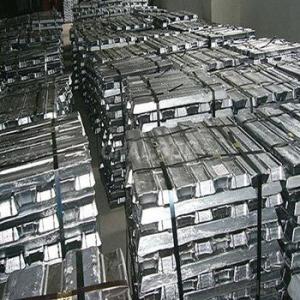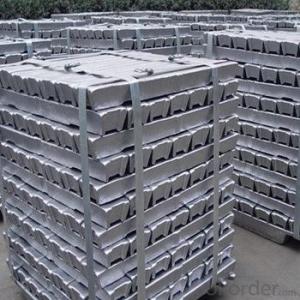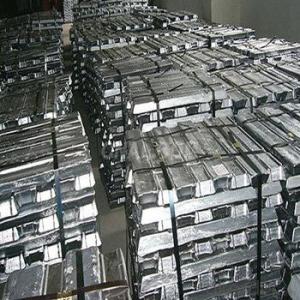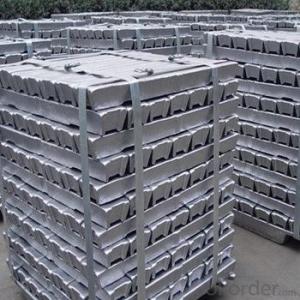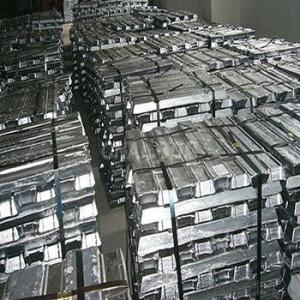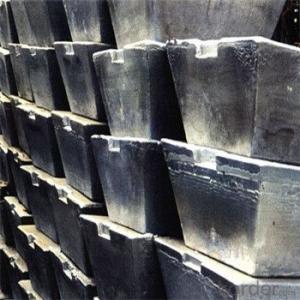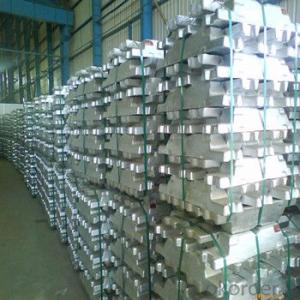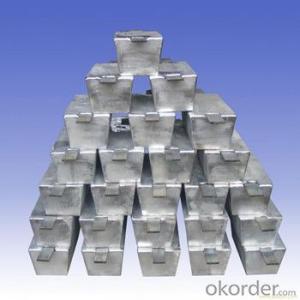Aluminum Pig/Ingot Popular Among Customers
- Loading Port:
- China main port
- Payment Terms:
- TT OR LC
- Min Order Qty:
- 1000 m.t.
- Supply Capability:
- 100000 m.t./month
OKorder Service Pledge
OKorder Financial Service
You Might Also Like
Pure Aluminum Pig/Ingot Used for Industry
1.Structure of Aluminum Pig/Ingot
A material that has been cast into a shape in order to be transported and processed easier than in an unprocessed form. An ingot is typically rectangular in shape, which allows it to be stacked. Ingots are most commonly associated with metals, with ingots of gold held in the vaults of banks and brokerages being popular images.
Aluminum Ingot is with the AL as the main chemical composition.Aluminum Ingot is used for industry,such as automobile,pinning and weaving,electron broadly and so on. Aluminum Ingot has the following advantages: easy control and operation, fast melting.
2.Main Features of the Aluminum Pig/Ingot
•High Purity
•Easy control and operation
•High strength
•Fast melting
•Competitive price
•Best Service
3.Aluminum Pig/Ingot Images
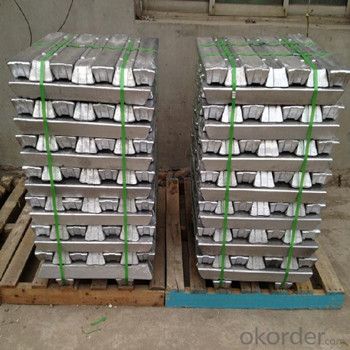
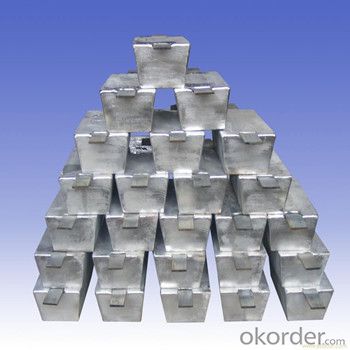
4.Aluminum Pig/Ingot Specification
Grade | Chemical Composition % | |||||||||
Al≥ | impurities ≤ | |||||||||
Si | Fe | Cu | Ga | Mg | Zn | Mn | others | Sum | ||
Al99.9 | 99.90 | 0.50 | 0.07 | 0.005 | 0.02 | 0.01 | 0.025 | - | 0.010 | 0.10 |
Al99.85 | 99.85 | 0.80 | 0.12 | 0.005 | 0.03 | 0.02 | 0.030 | - | 0.015 | 0.15 |
Al99.7 | 99.70 | 0.10 | 0.20 | 0.010 | 0.03 | 0.02 | 0.030 | - | 0.030 | 0.30 |
Al99.6 | 99.60 | 0.16 | 0.25 | 0.010 | 0.03 | 0.03 | 0.030 | - | 0.030 | 0.40 |
Al99.5 | 99.50 | 0.22 | 0.30 | 0.020 | 0.03 | 0.05 | 0.050 | - | 0.030 | 0.50 |
Al99.00 | 99.00 | 0.42 | 0.50 | 0.020 | 0.03 | 0.05 | 0.050 | - | 0.050 | 1.00 |
5.FAQ of Aluminum Pig/Ingot
We have organized several common questions for our clients,may help you sincerely:
①How about your company?
A reliable manufacturer & supplier of Aluminum Pig/Ingot,with many years’ experience in producing Aluminum Pig/Ingot.The items have beedn exported around the world,and have been acceptable among the customers,and have gotten the good reputation already.No matter from the quality,price and service,can be guaranteed for the cusgtomers.High purity and diffent grade are available.
②How to guarantee the quality of the products?
We have established the international advanced quality management system,every link from raw material to final product we have strict quality test;We resolutely put an end to unqualified products flowing into the market. At the same time, we will provide necessary follow-up service assurance.
③How long can we receive the product after purchase?
In the purchase of product within three wo We have organized several common questions for our clients,may help you sincerely:
- Q:What are the different forging techniques for aluminum ingots?
- Some of the different forging techniques for aluminum ingots include open-die forging, closed-die forging, and ring rolling. In open-die forging, the aluminum ingot is placed between two flat dies and compressed to shape it. Closed-die forging involves using shaped dies to create intricate and precise shapes. Ring rolling is a specialized technique where the ingot is rolled into a ring shape using radial and axial forces. These techniques allow for the production of a wide range of aluminum products with varying shapes and sizes.
- Q:What are the properties of aluminum ingots?
- Aluminum ingots possess several distinct properties that make them highly valuable in various industries. First and foremost, aluminum ingots exhibit exceptional lightness, as they have a low density compared to other metals. This property makes them ideal for applications where weight reduction is crucial, such as in the aerospace and automotive sectors. Additionally, aluminum ingots possess excellent corrosion resistance, making them suitable for use in environments where exposure to moisture, chemicals, or harsh weather conditions is probable. This corrosion resistance is due to the formation of a thin, protective oxide layer on the surface of the ingot, which prevents further oxidation and deterioration. Another notable property of aluminum ingots is their high thermal conductivity, allowing them to efficiently transfer heat. This characteristic is particularly advantageous in heat exchange systems, where the ingots can facilitate the transfer of thermal energy. Moreover, aluminum ingots also exhibit excellent electrical conductivity, making them suitable for applications in the electrical and electronics industries. Furthermore, aluminum ingots have a high strength-to-weight ratio, making them strong yet lightweight. This property allows for the construction of structures that require both strength and durability without compromising on weight. Moreover, aluminum ingots are easily recyclable, retaining their properties even after multiple recycling processes, which makes them an environmentally friendly choice. Overall, the properties of aluminum ingots, including their lightness, corrosion resistance, thermal and electrical conductivity, high strength-to-weight ratio, and recyclability, contribute to their widespread use in various industries, ranging from transportation and construction to packaging and consumer goods.
- Q:Process description of aluminium ingot
- The commonly used method for casting blend furnace can be divided into two ways of casting casting and continuous casting and continuous casting and vertical semi continuous casting. Continuous casting machines are used. The mixing furnace is to pour the aluminum liquid into the mixing furnace and to be poured by the mixing furnace. It is mainly used for the production of remelting ingots and casting alloys. Casting is carried from ladle directly to casting machine, mainly in the casting equipment can not meet the production, or the quality of raw materials is too poor, can not be directly into the furnace. Since there is no external heating source, the lifting package has a certain temperature, usually in summer at 690~740 degrees, and winter at 700~760 degrees, to ensure a better appearance of aluminum ingots.Mixing furnace, the first to go through the ingredients, and then poured into the mixing furnace, stirring evenly, and then add flux refining.
- Q:What is the difference between remelting aluminium ingot and alloy aluminium ingot?
- General remelting aluminum ingot is a waste aluminum melting by boiler, is a small factory recycling processing! The standard alloy aluminium ingot is made of A00 aluminum according to the requirement and various metal proportion
- Q:How are impurities removed from aluminum ingots during production?
- Impurities are eliminated from aluminum ingots in the production process through a refining process. The refining process typically consists of two primary steps: degassing and filtration. During degassing, the aluminum melt undergoes high temperatures and low pressures. This assists in the removal of volatile impurities, such as hydrogen, which can lead to porosity and brittleness in the end product. The high temperature and low pressure conditions permit the impurities to escape as gas bubbles, which are subsequently extracted from the melt. Filtration follows as the subsequent stage of impurity removal. The aluminum melt is passed through a filtration system containing ceramic filters or other porous materials. These filters are designed to trap solid impurities like oxides, non-metallic particles, and other foreign materials. The filters possess a specific pore size that exclusively allows the molten aluminum to pass through while retaining the impurities. This filtration process aids in enhancing the quality of the aluminum by reducing the levels of non-metallic inclusions, which can detrimentally impact the mechanical properties of the final product. It also contributes to regulating the grain structure and enhancing the overall homogeneity of the aluminum ingots. In conjunction with degassing and filtration, other refining techniques, such as fluxing and electromagnetic stirring, may also be implemented based on the specific requirements of the production process. Fluxing encompasses the addition of chemical compounds to the aluminum melt to facilitate impurity removal. Electromagnetic stirring employs electromagnetic fields to augment the mixing and distribution of the melt, thereby assisting in impurity elimination. Overall, impurities in aluminum ingots are effectively eliminated during production by combining degassing, filtration, fluxing, and electromagnetic stirring processes. These refining techniques guarantee that the final aluminum product adheres to the desired quality standards and exhibits optimal mechanical properties.
- Q:How are defects in aluminum ingots repaired?
- Depending on the type and severity of defects, there are several methods available for repairing aluminum ingots. One commonly used technique is remelting, where the flawed ingot is melted down and recast to eliminate any impurities or defects. Through this process, the metal is refined and the original defects are eradicated. Another method, known as hot working, is employed to repair defects in aluminum ingots. This involves heating the ingot to a specific temperature and subjecting it to mechanical processes such as rolling, forging, or extrusion. Hot working effectively reshapes the metal, redistributes the defects, and enhances the overall quality of the ingot. Heat treatment is an additional process that can be utilized to repair defects in aluminum ingots. By subjecting the ingot to controlled heating and cooling cycles, its microstructure is altered, and defects like cracks or voids are eliminated. Heat treatment improves the mechanical properties and structural integrity of the ingot, rendering it suitable for various applications. Furthermore, defects in aluminum ingots can be rectified through welding or surface machining. Welding is particularly effective for repairing cracks or fractures, while surface machining can eliminate surface defects like dents or scratches. It is worth noting that the choice of repair method depends on the nature and extent of the defect, as well as the intended application of the aluminum ingot. Manufacturers and specialists in aluminum production and processing employ diverse techniques to ensure that defects are successfully repaired, resulting in high-quality aluminum products.
- Q:What is the re ingot?Please give me a detailed explanation
- Of course, some people do not cast ingots complex, he will cast silicon, aluminum water and how many percent how many turns into a silicon ingot casting furnace, and then sold to the inside of the ingot, the content inside the complex ingot is to know what tests!
- Q:REGAL-S33N what is the aluminum ingot material?
- Product (Unwrought). A product obtained by smelting (or refining) and casting. For example, rolling ingot, extrusion ingot, forging ingot and remelting aluminium ingot.
- Q:How can the sustainability practices in aluminum ingot production be enhanced?
- There are several ways in which the sustainability practices in aluminum ingot production can be enhanced. Firstly, the adoption of cleaner and more energy-efficient technologies can greatly reduce the environmental impact of the production process. This could involve the use of renewable energy sources, such as solar or wind power, to power the production facilities. Upgrading equipment and machinery to more energy-efficient models can also help minimize energy consumption and reduce greenhouse gas emissions. Secondly, optimizing the recycling and reuse of aluminum scrap and waste materials can significantly reduce the need for virgin aluminum production. Implementing effective recycling programs and investing in advanced recycling technologies can ensure that a higher percentage of aluminum is recovered from end-of-life products and incorporated back into the production process. This not only conserves valuable resources but also reduces the energy-intensive extraction and refining processes associated with primary aluminum production. Thirdly, improving water management practices can contribute to enhanced sustainability in aluminum ingot production. Implementing efficient water conservation measures, such as recycling and reusing water within the production process, can help minimize water consumption. Additionally, implementing wastewater treatment systems to remove pollutants and contaminants from the discharged water can prevent water pollution and protect local ecosystems. Furthermore, promoting transparency and responsible sourcing practices in the supply chain can enhance sustainability in aluminum ingot production. This includes ensuring that the raw materials used in the production process, such as bauxite and alumina, are sourced from responsible and sustainable mining practices. Implementing traceability systems and certification programs can help verify the origin and sustainability of these materials, ensuring compliance with ethical and environmental standards. Lastly, engaging with stakeholders, including employees, local communities, and industry associations, can foster a culture of sustainability and drive continuous improvement in aluminum ingot production. This can involve regular training and awareness programs on sustainable practices, as well as collaborating with suppliers and customers to identify and implement innovative sustainability solutions. Overall, enhancing sustainability practices in aluminum ingot production requires a holistic approach that combines technological advancements, efficient resource management, responsible sourcing, and stakeholder engagement. By implementing these measures, the aluminum industry can minimize its environmental footprint and contribute to a more sustainable future.
- Q:What is the role of aluminum ingots in the production of cans?
- The production of cans relies heavily on aluminum ingots, which serve as the primary raw material in the manufacturing process. These ingots are melted and then shaped into the desired size and form of the can. Aluminum is the chosen material for cans due to its exceptional properties. Its lightweight nature makes transportation and handling easier. Additionally, it is highly durable and resistant to corrosion, ensuring the cans effectively safeguard their contents. After the aluminum ingots are melted and shaped, they undergo several processes to transform into the final can. This involves shaping, forming, and coating to ensure strength and withstand the pressure exerted by carbonated beverages. Moreover, aluminum ingots enable convenient recycling of cans. Aluminum is a highly recyclable material, and incorporating ingots in the production process guarantees that cans can be recycled and reused multiple times without compromising quality. In conclusion, aluminum ingots play a crucial role in can production, providing the essential raw material for lightweight, durable, and recyclable containers extensively used in the beverage industry.
1. Manufacturer Overview |
|
|---|---|
| Location | |
| Year Established | |
| Annual Output Value | |
| Main Markets | |
| Company Certifications | |
2. Manufacturer Certificates |
|
|---|---|
| a) Certification Name | |
| Range | |
| Reference | |
| Validity Period | |
3. Manufacturer Capability |
|
|---|---|
| a)Trade Capacity | |
| Nearest Port | |
| Export Percentage | |
| No.of Employees in Trade Department | |
| Language Spoken: | |
| b)Factory Information | |
| Factory Size: | |
| No. of Production Lines | |
| Contract Manufacturing | |
| Product Price Range | |
Send your message to us
Aluminum Pig/Ingot Popular Among Customers
- Loading Port:
- China main port
- Payment Terms:
- TT OR LC
- Min Order Qty:
- 1000 m.t.
- Supply Capability:
- 100000 m.t./month
OKorder Service Pledge
OKorder Financial Service
Similar products
New products
Hot products
Related keywords
